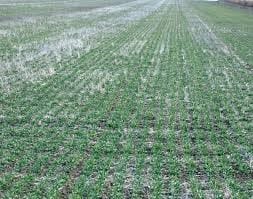Good afternoon,
Another week has gone by and harvest is progressing as weather permits. State averages have Ohio behind with corn harvest at 52% completed and soybean harvest at 72% as of November 2 according to the most recent Crop Progress report released by the USDA. This is quite a change from just a week earlier. Normally by this time, 55% of the corn would be harvested and 83% of the soybeans would be in the bin. 90% of the winter wheat has been planted in Ohio, as documented by this report. Locally here in Hardin County, I would estimate that 50% of the corn is harvested and about 75% of the soybeans have been cut.
As mentioned before, tomorrow afternoon (November 6) is the Dairy Farm Bill program at the Union County Services Building, 940 London Avenue in Marysville from 1:00-3:00 pm. This meeting is for dairy producers to help understand their options for the new Dairy Margin Protection Program (MPP). It was recently announced that the USDA has now delayed the enrollment deadline for the new dairy MPP to December 5, 2014 at local Farm Service Agency office. However, the combined meeting for Hardin, Logan, Union, Champaign, and Delaware counties will go on as scheduled. See the attached news release for more specific information.
Dairy Farm Bill Meeting News Release
Other meetings coming up are Extension Advisory Committee tomorrow (11/6) starting at 11:30 am at the Extension office, Ag Council meeting on Friday (11/7) with program on farm solar power starting at 7:00 am at Henry’s Restaurant, and Christmas Around the Square Saturday (11/8) starting at 9:00 am at the courthouse with the Master Gardener Volunteers. The Sheep Improvement Association will be meeting Tuesday (11/11) starting at 7:30 pm at Ag Credit. I have attached an interesting article about Soil Structure and Cereal Rye, written by Putnam County Extension Educator Jim Hoorman. In addition, an article about the Delayed Harvest written by Hancock County Extension Educator Ed Lentz is also attached to this newsletter. Below are some articles you may be interested in reading.
Mark
Late Fall Weed Control in Winter Wheat – Mark Loux
There are effective late-fall post-emergence options for management of dandelion and winter annual weeds in wheat for use mostly in those fields that were not treated with burndown herbicides prior to emergence. For late-planted fields where wheat has not emerged, it?s still possible to use the full range of burndown herbicides discussed in a previous article (http://corn.osu.edu/newsletters/2014/2014-32/#5). A couple of questions we received lately about burndown are included in the full article which can be found at http://corn.osu.edu/newsletters/2014/2014-37/late-fall-weed-control-in-winter-wheat.
Using Corn Stalks – Rory Lewandowski
As corn harvest progresses, don’t overlook corn stalks as a feed resource. Corn residue can meet the nutrient needs of ruminant livestock that are in early to mid-gestation. The University of Nebraska has done a lot of research on the topic of grazing corn residue. A University of Nebraska study conducted over a 5 year period from 2004 to 2009 measured corn grain left in the field after harvest. An average of 1.0 bu/acre was available for livestock grazing. A 2004 Nebraska beef report on corn stalk grazing included more information about the make-up of corn residue. Generally, stalks account for 49% of the residue dry matter, leaves 27%, husks 12% and cobs another 12% of the residue dry matter. Livestock typically consume any corn grain first. After the grain, plant leaves and husks are eaten and the last portions of residue eaten are cobs and stalks. To continue reading this and other beef articles, go to http://u.osu.edu/beef/2014/10/29/using-corn-stalks/#more-691.
2015 Commercial Pesticide Recertification Conferences – Curtis Young
Registration for 2015 Commercial Pesticide Recertification Conferences is now open. There are four conferences being offered in 2015. The locations for the conferences are Sandusky, Ohio, Kalahari Convention Center (Thursday, January 22, 2015), Dayton, Ohio, Dayton Convention Center (Thursday, January 29, 2015), Akron, Ohio, John S. Knight Center (Wednesday, February 18, 2015), and Columbus, Ohio, Columbus Convention Center (Wednesday, March 11, 2015). Commercial pesticide applicators needing recertification credits for the renewal of their pesticide applicator’s license should register to attend one of these four state commercial pesticide recertification conferences. For more information on each of these sites and to register, visit the OSU Pesticide Education Program’s web site at: [ http://pested.osu.edu ]. The links to each of the conferences are on the front page of the PestEd web site. It can also be found at https://agcrops.osu.edu/newsletter/corn-newsletter/2014-37/2015-commercial-pesticide-recertification-conferences.
Milk Prices, Costs of Nutrients, Margins and Comparison of Feedstuffs Prices – Dr. Normand St-Pierre
As I write this column in late October, the Class III futures have just closed at $23.89 for October, $21.25 for November, and $19.20/cwt for December 2014. For the next 12 months, the Class III milk futures are averaging $18.29/cwt, which (IF these are accurate predictors) should provide Ohio dairy producers with a mailbox price averaging around $19.00/cwt over the next 12 months. The problem is that I don?t think that the futures markets will turn out to be accurate in this instance. In my opinion, they are overly optimistic. To find out why, continue reading this and other dairy articles at
http://dairy.osu.edu/bdnews/Volume%2016%20issue%205%20files/Volume%2016%20Issue%205.html#Quick.
Ohio Livestock Mortality Composting Certification Training ? Ohio Pork Information Center
Composting livestock and poultry mortality in agricultural operations is a legal option for disposal in Ohio. This required training session will certify operators to compost livestock mortality of approved species and apply the compost to fields. It is hoped this will expand operator?s options for disposal and enable them to improve the efficiency and profitability of farm enterprises. A Livestock Mortality Composting Certification workshop is scheduled for November 19th at the Putnam County OSU Extension Office in Ottawa and begins at 6:30 p.m. To register: http://porkinfo.osu.edu/content/educational-opportunities.
Mark A. Badertscher
Agriculture and Natural Resources Educator
OSU Extension Hardin County
1021 W. Lima Street, Suite 103, Kenton, OH 43326
419-674-2297 Office





